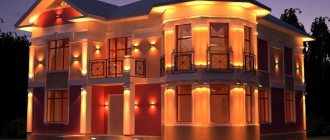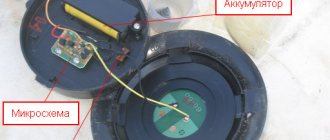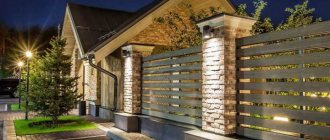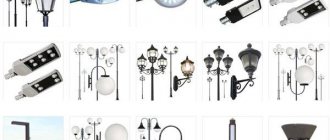Modern lamps for creating street lighting must meet basic requirements: be bright, durable, and energy-saving. When choosing the right lamp for a street lamp, you should pay attention to the base - it must match the lamp socket. The following types of lamps are used today:
- Mercury arc lamps (MAV)
- High Pressure Sodium Lamps (HPSV)
- LED bulbs
Most often, RKU or HKU lamps are required for connection; today this is still the main type of lamps for street lighting. Let's take a closer look at all the types of lamps presented.
Norms and requirements
When designing and installing street lighting in the yard, it is important to be guided by basic standards, which in the future will ensure not only the ease of use of the local area, but also human safety:
- In accordance with clause 6.3.1 of the PUE for external lighting devices in the yard, you can use lamps of any principle of operation with the exception of security alarm devices, in which the installation of gas-discharge equipment is not allowed
- The installation location of lighting devices can be organized both on free-standing supports and on structural elements of buildings, structures, on the ground, on cables according to clause 6.3.2 of the PUE . But when hanging on a rope in accordance with clause 6.3.4 of the PUE, measures must be taken to prevent them from swinging.
- In relation to the ground, in accordance with clause 6.3.6 of the PUE, you can choose any height, however, when installing yard lighting in the ground, you must provide the installation site with a drainage system.
- If the luminaire is located on any structures below 2.5 m in accordance with clause 6.1.15 of the PUE, their level of protection from dust and moisture must be at least IP54.
- In accordance with clause 6.6.8 of the PUE, the installation of lighting devices must ensure a sufficiently reliable degree of fixation.
- Based on the requirements of clause 6.6.1 of the PUE, the installation location of lighting devices in the yard should be chosen so that there is easy access to it.
- In the regulations of clause 6.6.4 of the PUE , suspended models with a flexible holder are lowered no lower than 1.5 m, otherwise anti-swaying devices are applied to it.
Basic requirements for street lighting
It is important to understand that outdoor lighting is completely different from indoor lighting, primarily in design. The technical data and, of course, the installation method are also different. When choosing street lighting lamps, you should take into account completely different priorities.
Firstly, when choosing street lights, there is no need to pay attention to color indicators, which are necessarily taken into account when choosing indoor lighting. In this case, the power or light output of the device is much more important. Secondly, it is important to consider the duration of operation, since replacing lamps is a process that requires a lot of time and effort. In addition to the above, replacing outdoor lighting often requires special equipment, so the duration of the work is an important criterion to consider when choosing.
Purpose of lanterns
The installation location of lamps in the yard is determined by the need to illuminate a particular area: the entrance, garden path, flower bed or pond. Depending on the tasks assigned, yard lighting devices can be divided into several categories.
Functional
The main task of functional lighting is to provide sufficient visibility in any area. Thanks to this type of lighting in the yard, you can ensure safe movement after dark.
Various types of lighting equipment can be installed for street lighting:
- Lamps and spotlights installed on the facade of a building or free-standing supports help illuminate garden areas, local areas, etc.
- Landscape street lights - characterized by low legs or direct installation in the ground, provide visibility of paths of buildings and structures in the yard.
- Floor lamps for street lighting are located at human height and are designed to illuminate a small area around, roads, driveways, entrances, gardens and other elements.
In addition to a powerful luminous flux, functional lighting must also ensure minimal energy consumption, so it is worth using LED lights here.
Security
Designed solely to prevent unauthorized entry of strangers into or near the yard. Used to illuminate any area of your home, space, area, etc. Constantly switching on the light at the entrance gate, fence or generally around the perimeter provides good visibility, but this is too expensive. Therefore, it is advisable to automate security lighting using a motion sensor, so that the lighting devices act as an alarm system, notifying that a person is approaching.
Decorative
Used to decorate the yard, its individual sections, flower beds, vegetation, ponds, stairs. Street lighting helps to effectively highlight important elements in the garden and act as architectural lighting. For decorative lighting, spotlights, spotlights, and LED strips are equally used. An important criterion when choosing specific equipment is its compliance with the landscape design and the general style of the buildings in symbiosis with which they will be used.
Festive
Festive courtyard lighting is intended to decorate the area for a specific event - New Year, birthday, etc. Unlike the previous type, they are installed temporarily - in relation to some holiday. Here you can also use architectural lighting, lighting paths, decorating gazebos and terraces. Garlands, LED strips and themed lamps are used as courtyard lighting devices.
Variety of models
Limited choices have long given way to a variety of materials that are used to create lamps for household and street lighting. Currently, these can be options such as steel, plastic, glass, forging, as well as all possible combinations of the listed options. The various stylistic solutions of modern lighting sources are also pleasing. On store shelves you can find original products made in high-tech, modern, baroque, and classic styles.
Selecting suitable luminaires
It should be noted that the choice of lighting devices for suburban areas and private houses should be carried out according to three main criteria:
- installation height of lighting equipment in relation to floor level;
- angle of distribution of the luminous flux from the lamp;
- area of the illuminated area and surface of the object.
According to the type of luminous flux distribution, all yard lighting devices are divided into:
- common with diffuse flow;
- common with directed flow;
- local;
- hidden.
According to the method of location relative to the load-bearing and mounting structures, fastenings to the surface are divided into:
- Ceiling - the lamp is suspended from the upper plane of the building, on a support console, bracket, etc. It is good to install on terraces, under the roof at the entrance, near the walls of buildings.
- Wall-mounted – provide a smaller light distribution angle than the previous option, also suitable for entering a house, gate, illuminating the perimeter of a building, fences, building elements.
- Floor lamps - suitable for garden paths, platforms, entrances to the yard, etc.
- Recessed - cover a huge segment of lighting devices that can be mounted in walls to illuminate the facade, ground, ceiling and other surfaces, depending on your needs.
- On a short leg - used as decorative lighting of an area, paths or perimeter.
Mercury arc lamps (MAV)
It is impossible to imagine lighting streets, parks, highways and roads without mercury lamps. They perform the main functions assigned to them - they shine brightly and last a long time, and their energy efficiency is almost four times higher than incandescent lamps!
The bulb of the DRL lamp has a somewhat elongated shape and is of decent size. The walls of the flask are coated with a phosphor, which begins to glow under the influence of ultraviolet radiation when voltage is applied to the lamp. Many models have a reflective surface on the inside of the bulb, this provides additional brightness. To operate the lamp you will need ballasts.
| DRL mercury lamp OSRAM HQL 250W E40 | DRL mercury lamp NATRIUM LRF 400W E40 | DRL mercury lamp OSRAM HQL 400W E40 DE LUXE |
High Pressure Sodium Lamps (HPSV)
Sodium lamps are very good for street lighting. Of all the types of gas discharge lamps, they shine the brightest. Thus, a 250 W DRL lamp provides 13,000 lumens of luminous flux, and a HPS lamp with the same power - all 25,000. This difference, of course, is an additional advantage in favor of sodium lamps. DNAT emits bright orange light, which is not very pleasant to the eye if the lamp is located nearby, but for illuminating streets, avenues, parks, squares and roads, this is the best option.
The glass bulb of a sodium lamp contains a burner filled with a mixture of mercury and sodium vapor; xenon is used for ignition. When voltage is applied to the lamp, a glow is formed under the influence of sodium vapor. HPS heats up very strongly - up to 300 degrees. Of course, if even one drop of water hits a lamp in working condition, an instant explosion of the bulb is possible, so you should carefully select lamps. To connect the HPS, you will need ballasts.
| Sodium lamp HPS OSRAM VIALOX NAV E 400W E40 | Sodium lamp BLV HST SE 400W E40 | Sodium lamp OSRAM VIALOX NAV T 1000W E40 |
Selecting the lighting control type
Depending on the frequency of use, all yard lighting devices can be divided into devices with automatic and manual activation. The first method is relevant for those houses where the light in the yard should come on with the onset of darkness and go out with the first rays of dawn. If you want to control the lighting process yourself, it is better to install manual or mechanical switching.
Mechanical
To implement the mechanical switching on of lighting in the yard, key switches or contactors are installed. The first option is used for low-power loads, when one switch runs several LED lamps with low power. The contactor is used to switch powerful lighting in the yard when you have several lighting groups installed that create a large load. At the same time, you can divide all the yard lighting groups under several key switches or buttons if you run them using a remote control.
Automatic
Lighting automation allows you to eliminate the human factor as much as possible from controlling the switching process. This will allow you not to worry about lighting while you are away or eliminate the need to constantly turn on and off yard lighting.
To implement automatic backlighting, the following can be introduced into the power supply circuit of LED spotlights:
- photo relay - turns on the yard lighting when it gets dark;
- motion sensor - supplies power only when moving in a given area of space;
- time relay - allows you to set a program for turning on and off in a certain time interval (from a daily schedule to several minutes).
All of the above automation tools can be installed either separately or together. For this, a serial connection diagram is used, as shown in the figure below:
Automation on/off
Despite the fact that the presence of sensors requires additional costs and also complicates installation, it is convenient and economical. There are time relays that can turn the street lights of a house on and off at a given time. It makes sense to install such systems on security and functional lighting. You can also think about installing a relay for decorative lighting - also convenient.
Street lighting at home consists of several parts
In less-frequented places, where you only need to turn on the lights when you are there, you can install motion sensors. They can also be part of security lighting - if there is movement, spotlights that were not working before will turn on. The surprise will not be pleasant. Another thing is that the sensor can trigger on a dog or other animal that comes into its field of view. But the security functions will still be more effective.
Another opportunity to automate the street lighting of a private home is to install a photo relay. It reacts to a decrease in the amount of light, including the lamp power circuit. Also in automatic mode, the power turns off when the sun begins to rise.
Another video on the topic
Nuances of electrical installation work
When installing and connecting lighting fixtures in the yard, several important nuances should be taken into account:
- Before starting work, draw up a yard lighting diagram linked to the site plan - this will save time and money spent on incorrect calculations.
- It is more expedient to lay the electric cable in the ground - this will preserve the aesthetics of the yard; the depth of its location should be at least 0.8 m.
- All lamps must have a quality certificate allowing them to be used outdoors. Otherwise, over time, the housing may collapse from exposure to atmospheric factors.
- The connection points and connections of the supply wires must be buried in a sealed box that prevents moisture from entering.
- Street wires running along the open part of the facades must be protected from exposure to sunlight.
- You can install solar-powered LED lamps, but you won't get much light from them.
Types of street lamps
Types of street lampsNowadays, street lights are used not only to improve visibility at night, but also for aesthetic purposes. Elegant lanterns along the perimeter of the site, original lamps above the porch and laconic posts along the park paths allow you to decorate the local area and clearly mark the boundaries of the property. Let's figure out what street lighting can be like and what criteria to use to choose lamps.
Let's start with a historical educational program. The first street lighting system appeared in the Dutch capital in the 17th century. Back in 1669, artist and inventor Jan van der Heyden proposed installing almost 2,500 oil lanterns on the streets of Amsterdam. The project was successfully used right up to 1840.
The experience of the Dutch was gradually adopted by other European cities. London, for example, acquired street gas lamps in 1807. In Russia, street lighting began to be established even earlier: in 1718, lanterns that burned with hemp oil appeared in St. Petersburg, and in 1730 - in Moscow.
Already at the end of the 19th century, streets began to be illuminated with electric lamps. Well, since the 20th century we have been using gas-discharge and LED.
Classification of lamps by light source
It can be:
- incandescent lamp (bulb filled with inert gas or halogen vapor) - if the first option is practically not used for street lighting due to its inefficiency, then the second is often used in lanterns and spotlights;
- mercury, sodium or metal halide gas discharge lamp (an electric discharge is formed by burning propane, hydrogen, ethylene or methane) - it is durable, economical, highly efficient and not sensitive to voltage surges, so it is suitable for illuminating advertising signs, large buildings and even bridges;
- induction lamp (the light source is plasma formed when gas is ionized by a high-frequency magnetic field) - it is optimal for lighting tunnels, stadiums and parking lots and is undesirable for gas stations and airports;
- xenon lamp (the light source is an electric arc burning between a pair of electrodes in a xenon bulb) - it provides bright white light and is even suitable for illuminating large areas such as railway platforms;
- fluorescent lamp (the space between the electrodes is filled with mercury vapor, and the UV radiation created by the current is absorbed by the phosphor, which is why the glow is formed) - economical and reliable, it is optimal for constant bright illumination of open areas in front of hospitals, schools, private houses;
- LED lamp (the design includes a semiconductor chip, contacts, connecting conductors, a lens, a heat sink and other elements) - economical, bright and durable, it is ideal for illuminating courtyards, parking lots in front of offices and supermarkets, pedestrian areas, and outdoor skating rinks.
Outdated options that have not been used for outdoor lighting for more than a century include candle, kerosene and oil lamps.
Candle, kerosene and oil lamps
Other classification options for street lamps
They can be divided into:
- specialized (signal, search, special effect) - are used both in the army and navy, and in lighting exhibitions, festivals and other outdoor events;
- general use (flood lamps) - used to organize the illumination of buildings, courtyards, streets, and outdoor swimming pools.
Signal light and search light
Based on the principle of light distribution, street lamps are classified into circularly symmetrical and symmetrical. In this case, the latter are additionally divided into one- and two-plane.
Symmetrical and circular symmetrical lamps
According to the distribution of the luminous flux between the lower and upper hemispheres, diffused, direct and reflected light lamps are distinguished.
Street lamps can be classified according to other criteria, including:
- style (classical, modern, baroque and others);
- shape of the lampshade (luminaires with semi- and spherical, as well as conical, pyramidal and cylindrical lampshades);
- material for making the lampshade (aluminum, copper, steel, plastic, glass and others);
- energy source; Traditionally, lamps are connected to the electrical network, but for the sake of economy, solar energy accumulated during daylight hours can also be used. This is the easiest to install and most cost-effective type of lamps, ideal for illuminating summer cottages, public gardens, and architectural compositions.
Well, landscape lighting is divided into functional, security, decorative and architectural. Illumination stands apart.
Street lighting in populated areas and on intercity highways
Ring roads and other major roads, as well as highways, are illuminated with lanterns with a reflector, which is responsible for concentrating the light flux in the desired direction. The power of the lamps can reach 300-400 W. They must provide full illumination of areas and not dazzle drivers. The lanterns are mounted at a sufficient height, which makes it possible to dispense with diffusers and leave a large distance between the supports.
Highway lighting
Secondary roads are illuminated with lanterns with a reflector or diffuser. This is the name of a transparent lampshade that scatters light over an impressive distance. For lights on secondary roads, lamps with a power of 70-250 W are sufficient.
Transport stops, sidewalks, bike paths and park alleys are illuminated with lanterns with diffusers. They install lamps with a power of 45-120 W, selecting a specific option taking into account the distance between the supports.
House numbers, billboards, architectural monuments and facades of individual buildings are often illuminated with small spotlights. Their power can be 25-45 W.
Spotlights providing billboard illumination
Street lighting can be adjusted either manually or automatically. Flashlights with timers can turn on and off at a certain time, and lamps with sensors can turn on and off at a given light level.
Street lamps by mounting method and their use in landscape design
When designing site lighting, it is important to choose lanterns and spotlights that will harmoniously fit into the landscape design and create a special atmosphere. Most often used:
- Floor lamp type. This is a stand topped with a lampshade. It is considered not the best option for a small area, since the light flux here is directed upward. The use of a flashlight is more effective in large open spaces. Lamps are often mounted on fences along the perimeter of the territory.
Floor lamps
- Pendant lamp (ceiling). Visually, it is more or less similar to a classic chandelier, but is much more resistant to the negative influences of the external environment. With a lamp in a lampshade on a strong chain that is not afraid of even gusty winds, you can illuminate the space of a terrace, veranda, or gazebo.
Outdoor pendant lights
- Wall Light. This can be either a powerful spotlight, used mainly for reliable protection of the site, or a decorative option designed to effectively illuminate a pond, flower bed, alpine slide or garden path.
Outdoor wall lights
- Ground lamp. It is mounted directly into the ground and is often equipped with a protective canopy or decorative metal grille. They can be used to highlight the borders of a path, an exotic plant, a fountain or the entrance to a gazebo.
Ground lamps
- Floating lamp. The classic version assumes the presence of a spherical lampshade, although hemispheres are also found. This lamp has a waterproof body and is used to effectively illuminate an artificial pond, lake or pool. The lampshade can float on the surface of the reservoir or be attached to its bottom, which sometimes looks even more interesting.
Floating lamp
- Recessed lamp. It is mounted inside a horizontal or vertical surface and covered with a decorative grille or durable glass. The lamp is invisible during the day and indispensable at night. With its help, you can originally highlight a trimmed crown or entwined tree trunk, the outline of a pond or pool, a sculpture, a niche, or the entrance to a gazebo. Built-in lamps, especially models with matte shades, do not dazzle, so they can also be used to mark the boundaries of garden paths, lawns, and steps.
Recessed street lamps
What to look for when choosing street lamps
Lighting fixtures used outdoors have special requirements. They relate to safety, technical characteristics, installation methods and even design solutions.
Street lamps must be reliably protected from external influences. Temperature changes, precipitation, wind, as well as dust and high humidity can pose a danger to them. The threat can also come from vandals. That is why it is advisable to install durable lampshades on the streets that are difficult to open or break. The use of grilles helps to increase the level of protection of lamps.
Street lamps with grille
Characteristics such as color rendering are of secondary importance. Much more important, for example, is the ease of replacing lamps. If servicing street lamps involves the work of specialized equipment, you should choose the most durable option - a metal halide or LED lamp.
Street lighting should be selected taking into account climatic conditions. They play a decisive role when choosing a lamp according to the IP (Ingress protection rating) indicator - the level of protection against penetration. It includes two numbers:
- from 1 to 6 - the degree of protection of the housing from the penetration of dust or solid foreign particles into it;
- from 1 to 8 - the degree of protection of the housing from moisture penetration into it.
The indicator is indicated in the product passport. The documents for devices intended for street lighting must contain a minimum of IP44.
The efficiency of a luminaire can be assessed by the relationship between the luminous flux, which is measured in lumens, and the power, measured in watts. An LED flashlight, for example, can be characterized by a ratio of 100, 150 and even 200 lm/W.
When deciding on the mounting location for a street lamp, it is important to calculate the voltage. So, when purchasing lamps with voltages up to 12-24 V, which are planned to be connected to a 220-volt network, you should immediately purchase a step-down transformer.
It is advisable to think in advance about how the spotlight, lantern or lamp will be used: whether there will be a need to move the lamp to another place. If it is mobile, you will have to resolve the issue of organizing power supply each time. The only exception is solar-powered lighting: they work without wires, so everything is extremely simple.
Stationary and mobile lamps
You can choose a street lamp whose power is regulated by a dimmer. This is the name of a variator, which allows you to change the brightness of the lamps.
The stores also have lamps equipped with motion or noise sensors. Their use allows you to save energy.
Properly chosen street lamps not only perform an aesthetic function, but also allow people to feel safe and calmly move around the area.
Induction gas discharge lamps
Currently, induction lamps are increasingly used. The reason for this is mainly their long service life of approximately 50,000 hours, which makes lighting systems much easier to maintain. The efficiency of induction lamps is comparable to metal halide lamps, but the price is several times higher. One of the disadvantages of induction lamps is their more massive shape compared to other gas-discharge lamps, as well as their high frequency - these lamps can cause radio interference. Another negative factor is the decrease in luminous flux intensity at low temperatures, for example, at 0°C the reduction is 20% (and at -20°C it approaches zero).
Fluorescent lamps
Light sources based on the luminescence effect. In most fluorescent lamps, the argon-mercury gas mixture that fills the glass tube is activated by a flow of electrons, resulting in radiation in the ultraviolet range. The inner surface of the tube is coated with a phosphor that transforms ultraviolet light into visible light. It must be taken into account that the intensity of the luminous flux emitted by fluorescent lamps depends on the ambient temperature, i.e. at 0°C the lamp intensity decreases by 45% (and at -20°C it approaches zero).











